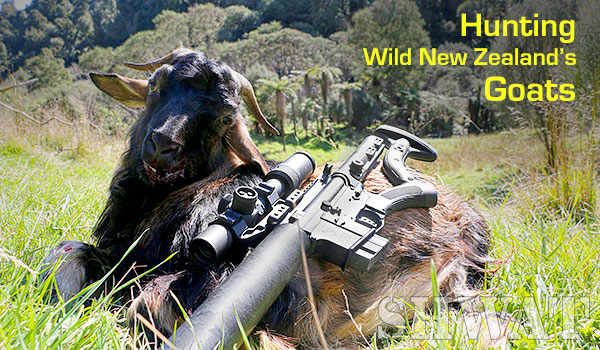
What do you get when you cross deer hunting with hog hunting and throw in a Kiwi accent? You get Taranaki wild goat hunting in wild New Zealand!
Wild goats in New Zealand are considered invasive and damaging to the native environment, so hunting is largely unrestricted and encouraged, as is the case in most areas with wild pigs, deer, and stag. You’ll want the right combination of gun, optic and ammunition, along with your spirit of adventure a decent level of physical stamina.
Goat Hunting on New Zealand’s North Island
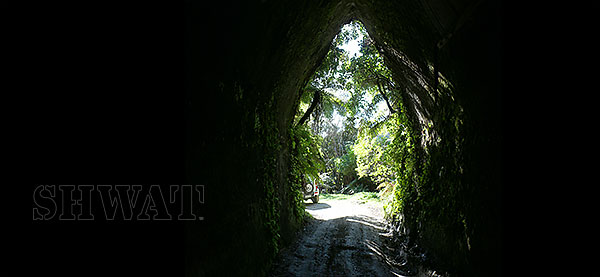
When you visit New Zealand, you must drive the Forgotten World Highway. Clinging to the side of cliffs, winding along a river gorge, crossing mountain passes, and threading through an ancient tunnel on the western side of the North Island, you travel a road that evolved from old colonial trails.
This particular autumn morning I was not traveling west to experience the beauty of the route. I was searching for Taranaki wild goats.
Maori legend holds that Mount Taranaki once resided in the center of the North Island, but after a bitter defeat he retreated toward the western coast, carving river valleys and shoving the earth up into tall vertical ridges as he waded through the earth.
As we topped a pass I saw the jumbled landscape far below stretching for miles, thrown up and stacked against itself; not a bit of flat land in sight as the sun burned off the morning mist. I grew up in Alaska eating mountain goats, which are found in vertical landscapes, so I immediately recognized that the Taranaki landscape was made for goats.
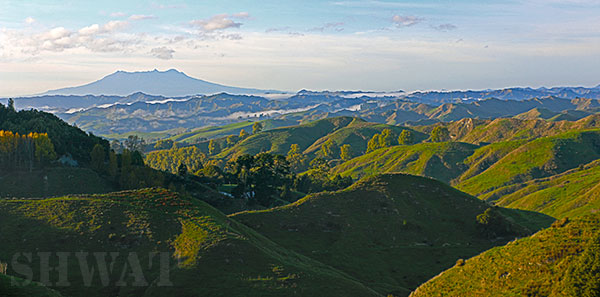
Dropping down from the mountain we began to see wild goats on the hillsides, and once, a massive wild hog.
We passed through the town of Whangamomona, a place that would be a natural fit if it were dropped into the most isolated areas of the Apalachians. If you ever pass through Whangamomona, be sure to have your passport handy, because you will want to have it stamped. Residents of this region consider themselves an independent republic, complete with their own president and passport.
We turned onto a precarious dirt track, stopping frequently to open and close sheep gates, until we reached a likely meadow that passed for flat, or at least not totally vertical, and I stopped to zero my rifle.
AR-15 for New Zealand Hunting
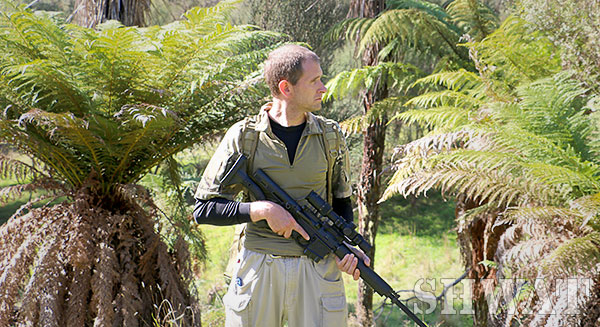
On this trip I brought what I consider to be an ideal rifle for hunting in New Zealand; an Alexander Arms 18″ Lightweight Hunter 6.5 Grendel AR-15. I have handled and fired heaps of AR-15s. You know how you can shoulder certain AR rifles, run the action, and just feel that everything is right? That is what you will feel with Alexander Arms rifles. Actions are smooth, triggers are crisp, and balance is superb.
In configuring the rifle to pass the somewhat restrictive Kiwi firearms laws, the rifle’s original stock was replaced with a Thordsen Customs FRS-15 stock. This stock may look a little unorthodox, but I love the futuristic design and usability of the stock. Other California (and New Zealand) compliant stocks may look clumsy and change the feel and manipulation of the rifle, but the FRS-15 stock looks sharp and certainly works well. And, unlike some other options, the Thordson FRS-15 stocks retains the normal manipulation of the safety selector. That’s a real advantage.
In the pictures here you might notice the lack of a muzzle device on my rifle. Flash hiders are note allowed. I’d ordered a thread protector for my barrel, but it didn’t come in before I left the US. Not the end of the world.
The top rail of the upper held a US Optics SR-8 1-8x scope in an Alamo Four Star DLOC-M4X mount. This is a great scope and mount combination with incredible flexibility. It proved ideal for hunting in New Zealand where terrain varies from dense foliage with all shots under 75 meters to open country and longer shots. You’ll need to pay attention to how you set this combination up on your AR-15.
The scope has a very long eye relief so it needs to be mounted more forward on the rifle than some others. And while the Alamo Four Star mount is nicely cantilevered forward to facilitate this, the SR-8 scope really needs a bit more.
There are two easy solutions. The first is to use a monolithic rifle upper or a handguard that gives a continuous top rail so that the mount can be moved forward slightly on the rifle. The other solution is to lengthen the stock.
It turns out that the TSA had removed my CLP from my rifle case, so I lubed the rifle with Automatic Transmission Fluid from the dipstick of the SUV. Resting on the hood, I quickly zeroed. The tight groups gave me confidence in the rifle’s accuracy.
Engaging the Goats
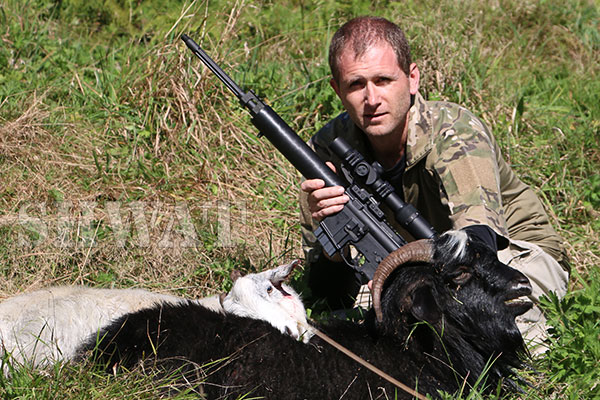
We continued a driving for a few more kilometers before dismounting to follow a track along a clear creek. Soon we crossed the creek, ascended, and broke out into a narrow valley. The left side of the valley was thick bush broken by a series of sloping meadows that ascended to a steep ridge above. The day was warm and sunny and goat sign was everywhere as we began to hunt through the meadows.
Entering the first long meadow, I noticed a finger of trees marching down into the meadow from the ridge, blocking my view of the left side of the meadow beyond. Through the trees I saw something that I momentarily took to be a goat, but realized it was a light-colored boulder and dismissed it.
As I began moving forward, my hunting partner, walking to my right, got my attention. Moving downhill to the right, my view cleared the trees and I could see more of the slope beyond, where a beautiful dark-colored goat was browsing in the meadow. Then the boulder lifted its head and I realized it was also a goat! Used to scanning for darker animals, I had seen the light goat, but recognized the dark one first.
I worked slowly downhill, moving forward and right to get a clear shot. As I moved, I three more goats came into view well up the slope. The dark goat, a billy, was the closest and largest at about 150 meters up the hill, while the white Nanny cropped grass about 25 meters uphill from him.
I aimed and fired a shot off-hand. The low recoil of the 6.5 Grendel allowed me to observe the impact through the scope even at such close range. The billy’s front legs folded and he landed hard on his chin. The white nanny bleated and sat down abruptly.
My instinct was to engage the three goats up-slope, but the white nanny had kept her front legs under her and was bleating again, so I immediately fired a shot into her chest and she rolled into her side. By now the other goats had started to react, but the dark goat was regaining his feet and making unsteady movements downhill, so I shot him in the neck.
I swung back to the more distant goats, but they were moving fast into the trees so I did not shoot. Instead, I switched my selector to safe and walked up the hill to inspect the goats.
When I fired my first shot, the Hornady 123 grain SST bullet broke the right leg of the billy at his shoulder before crossing his body and exiting through the ribs just behind his left shoulder. The bullet leaped across the intervening space and passed through the body of the white nanny, entering the ribcage on her right side and exiting the left side between the ribs and the rear leg. Exit wounds on both animals were impressive. The follow up shots had been unnecessary, but I wanted to ensure that suffering was short.
The goats were quartered and the meat cached in the shade. We pressed on across the meadow, through the bush, and broke out into the next meadow. This meadow was more varied, rolling over slight spurs and draws, and broken by clumps of mamaku and ponga trees.
We dropped into a grassy draw and then moved up the other side, advancing over a rolling spur. I was walking directly toward a tree in the open meadow when my hunting partner motioned for me to stop. Standing to my right, he was attempting to point out a goat.
I could see nothing, but stepped to the right, out of line with the tree, and saw the goat just across a gentle draw. It was standing in plain sight with the wind blowing from us directly towards it, but it appeared to be in deep contemplation and took no notice of us. I made a quick scan and saw that my lateral movement had revealed three more goats far up the hillside.
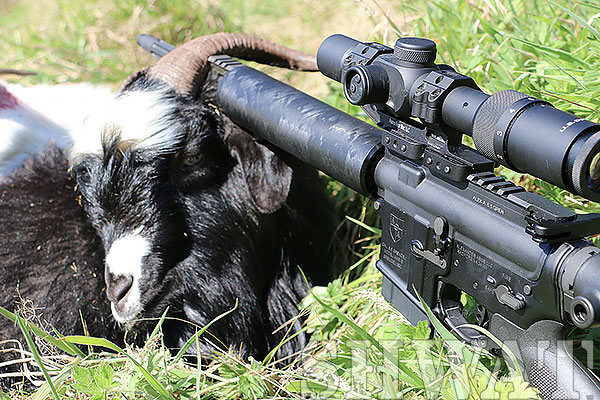
I aimed and shot the close goat, swung my rifle uphill and shot another goat, then swung back and snapped another shot into the first goat which was running downhill. She piled up under a mamaku fern and I turned the rifle uphill again, but the far goat was down and the others were running into the trees, so I held my fire.
We quickly butchered the two goats and moved on. Elevation increased and the meadows became smaller, steeper, and more separated. Before stepping into one meadow, I paused inside the tree line and scanned for goats. I couldn’t see far, because directly in front of me, at the other side of a small, sloping clearing, was a small rise flanked by trees and brush. A log lay across the crest at the far opening where there was a slight depression in the ground.
Beyond that, the meadow opened up. I wanted to move to that opening to see if there were any goats in the meadow beyond. I was moving slowly and silently forward when I heard a low exclamation. “In front of you!” I stopped and looked, but saw nothing in the large meadow ahead. “By that log!” he said.
I suddenly realized my mistake. Used to hunting larger animals, I had dismissed the shallow depression as too small for an animal to be hidden in and was scanning beyond it by the time I was close enough to see into it. Right there, 25 meters in front of me, two goats lay in the depression, heads raised, looking toward me over the log. I shot both goats in the face as fast as I could squeeze the trigger. The echoes of the shots rolled into one.
Neither animal had a chance to move. One died where it lay, and the other jumped up and flopped over.
I reckoned 6 goats were enough to pack out, so we butchered the last two and walked out under the afternoon sun. Hiking through the bush and meadows, I decided that even if we had found no goats, the beauty of the country alone would have made that hunt worthwhile.
Goats can be tough and they are famous for soaking up lead and fighting on when other animals would have dropped. These New Zealand goats proved tough as well, but were no match for the 6.5 Grendel. Not a single goat moved more than 100 feet, and most dropped where they stood. No bullet stopped in an animal; all exited and left impressive exit wounds. One bullet fully penetrated two goats, killing both.
This reinforced my opinion that the 6.5 Grendel is an ideal cartridge for hunting anything New Zealand has to offer, from wallabies to red stag. The performance was on par with my observations of other 6.5 mm cartridges on game, with performance and advantages of the 6.5s easily outstripping that of many .30 caliber cartridges.
I have found that the more uninformed hunters in Alaska are loath to eat a mountain goat, hunting for hides and horns and refusing to eat the excellent meat. The same attitudes about wild goats prevailed in New Zealand, and I was warned by several people not to eat the foul-tasting wild goats. This opinion came, of course, from people who had never tried wild goat. Roasted with garlic, potatoes, and kumara, legs from the younger goats were tender and mild, every bit as nice as venison or lamb.
Final Thoughts on New Zealand Goat Hunting
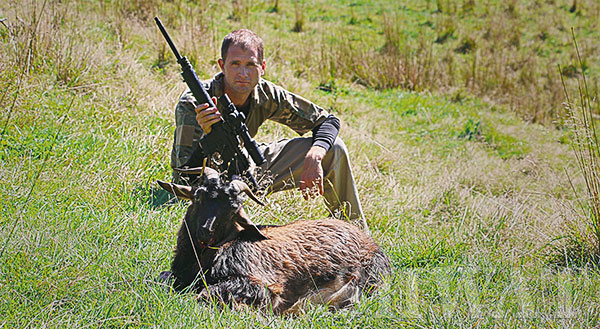
Goat hunting in New Zealand can be fun and fast, like a cross between dear and hog hunting, and an AR rifle is perfect for that type of hunting. I recommend the 6.5 Grendel, as it is a great cartridge for hunting any game in New Zealand, and ammunition is readily available.
If you are taking a rifle to New Zealand, be sure to check their approved firearms list and make sure any semi-auto rifle is configured to comply with New Zealand firearms code. You can apply for a New Zealand visitor’s firearms license before you travel and it will be waiting for you at the airport in New Zealand when you arrive.
If you have ever considered hunting overseas, it is hard to beat New Zealand. When you go, don’t be surprised if you run into me in the bush, 6.5 Grendel in my hands and a couple of goats on my back.


